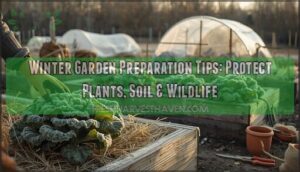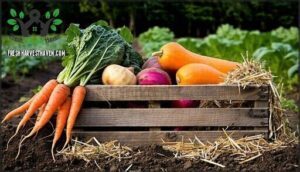This site is supported by our readers. We may earn a commission, at no cost to you, if you purchase through links.

The window for action is narrower than most gardeners realize. Once nighttime temperatures settle into the 50s, your checklist begins. Miss these weeks and you’ll spend spring replanting instead of harvesting.
Table Of Contents
- Key Takeaways
- When to Start Winter Garden Preparation
- Harvesting and Storing Late-Season Crops
- Protecting Plants From Frost and Cold
- Winterizing Vegetable and Herb Gardens
- Soil Care and Improvement for Winter
- Preparing Berry Patches and Perennial Beds
- Maintaining Trees, Shrubs, and Lawns
- Winter Garden Maintenance Tasks
- Supporting Wildlife and Garden Ecosystem
- Frequently Asked Questions (FAQs)
- How do I prepare my garden for winter?
- How can I Keep my Garden in a good shape during winter?
- What are winter gardening guidelines?
- How to prepare garden soil for winter?
- How do I succeed in winter gardening?
- What is winter gardening?
- What should I be doing in my garden in winter?
- What month do you start a winter garden?
- Should I fertilize my vegetable garden before winter?
- What are some winter gardening tips?
- Conclusion
Key Takeaways
- Winter prep starts when nighttime temps hit the 50s, and your timing window is narrower than most gardeners think—miss these weeks and you’ll spend spring replanting instead of harvesting.
- Hardy vegetables like kale can handle hard frosts and stay planted through late fall, while tender crops like tomatoes need protection before 32°F or they’ll suffer fatal damage.
- Mulching with 2-4 inches of organic material after the first hard frost reduces plant mortality by up to 40% and protects roots from freeze-thaw cycles that kill plants.
- Your garden becomes a wildlife refuge in winter when you leave leaf litter and hollow stems standing—this shelters 70% of native bee species and boosts pollinator populations by 35% come spring.
When to Start Winter Garden Preparation
Timing is everything for winter garden prep. Your first frost date and plant hardiness determine when you need to act.
Let’s break down how to schedule your tasks so nothing gets left out in the cold.
Timing for Different Plant Types
Your winterize garden strategy starts when you know your first frost date. Hardy vegetables like kale and spinach can handle hard frosts and stay planted through late fall. Semihardy vegetables tolerate light frosts but need protection below 28°F. Plant cool season crops 6–8 weeks before frost for best results.
Prepare perennials by mid-November before soil freezes. Spring bulbs go in when soil hits 40–50°F. Winter sowing of cover crops works best 3 weeks before killing frost.
Protecting plants from frost means timing mulch, coverings, and seed timing right for your plant hardiness zone. Understanding cool season gardening is essential for a successful winter garden.
Assessing Your Local Climate
Your USDA hardiness zone reveals your coldest average winter temperatures and guides plant selection. Check your zone using the 2023 map, which shows many areas shifted warmer by 5°F. But regional weather patterns matter too. Microclimates on your property can vary 5–10°F based on slope, shade, and wind exposure. Understanding the new plant hardiness zones is essential for gardeners to make informed decisions.
- Southern slopes warm up faster and extend your growing window by days
- Low-lying areas collect cold air and increase frost risk by 20%
- Urban heat islands keep nighttime temperatures 3–9°F warmer than rural zones
- Windbreaks cut ground wind speeds by half, stabilizing temperatures around plants
- Reliable snow cover insulates roots and raises soil temperatures 10–15°F
Scheduling Key Garden Tasks
Once you know your zone and microclimates, map out your fall gardening chores using seasonal planning.
Start cleanup when nighttime temperatures drop into the 50°F range. Plant spring bulbs between late September and late October.
Schedule soil testing every three years to guide winter amendments. Use garden calendars and weather monitoring to time deep watering before the first frost.
Task prioritization ensures irrigation drains happen before freeze-up, usually by mid-November, protecting your system through winter garden preparation.
Harvesting and Storing Late-Season Crops
As the growing season winds down, you’ll need to bring in your harvest before frost damage sets in. Some crops can handle the cold while others need immediate attention.
Let’s walk through what to harvest now, what can wait, and how to store everything properly.
Identifying Frost-Sensitive Vegetables
Your garden doesn’t have to be a guessing game when frost threatens. Tender vegetables like tomatoes, peppers, and cucumbers suffer fatal damage below 32°F, while eggplants and basil start declining even before freezing hits.
Understanding plant sensitivity and cold hardiness helps you classify what needs immediate frost protection and what can wait. Hardy vegetables tolerate hard frosts, but tender crops demand action now to prevent winter damage.
Harvesting Root Crops and Potatoes
Dig beets when roots reach 2–3 inches across, usually 50–70 days after planting. Carrots mature in 60–80 days and taste best when shoulders peek above the soil. For potatoes, wait until vine tops turn brown, then let tubers sit in the ground for 1–2 weeks so skins thicken for better storage.
Hardy vegetables like parsnips sweeten after frost and can stay put until you’re ready to harvest them, even into winter.
Proper Storage Methods for Produce
Temperature control is your first line of defense against spoilage. Store most vegetables at 32–40°F in the fridge to double or triple shelf life. Root cellars work best at 34–40°F with 90–95% humidity for carrots, beets, and cabbage.
- Keep leafy greens at 32°F and high humidity for up to three weeks
- Store apples in controlled atmosphere with reduced oxygen to extend freshness for six months
- Use breathable packaging to cut weight loss by 25% compared to open-air storage
- Monitor daily to stay within ±3°F for ideal produce packaging results
- Maintain proper airflow to boost shelf life extension by 50% and prevent mold
Proper storage optimization means less waste and fresh harvests well into winter, supporting both soil health and your compost pile with fewer scraps.
Protecting Plants From Frost and Cold
When winter temperatures drop, your plants need protection to make it through the season. The right strategy depends on what you’re growing and where it’s planted.
Here are four essential ways to shield your garden from frost and cold.
Mulching to Insulate Roots
Think of mulch as a winter blanket for your garden. A 2 to 4 inch layer of organic mulch stabilizes soil temperature and protects roots from harsh freeze-thaw cycles.
Apply shredded bark, wood chips, or pine needles after the first hard frost to lock in consistent conditions. Keep mulch 2 to 3 inches away from plant stems to prevent rot.
This simple step reduces plant mortality by up to 40% and maintains root zone warmth throughout winter.
Using Frost Cloths and Burlap
Frost protection methods work best when matched to your climate. Frost cloth materials like AG-30 polypropylene raise temperatures by 6–8°F and allow 85% light through. Use wire hoops to keep fabric off leaves. Seal edges with soil or bricks for stability.
Burlap wrapping shields evergreens and roses from winter weather by cutting wind exposure 25–35%. Wrap young tree trunks to prevent freeze cracks.
Remove winter plant covers when temps hit 50–60°F to avoid overheating.
Bringing Tender Plants Indoors
When nighttime temps consistently drop below 50°F, it’s time to bring tropical houseplants inside. Start with a pest inspection a week before—wash foliage and treat with neem oil. Quarantine plants for 7–14 days to catch hidden pests before mixing with other houseplants.
Gradually acclimate plants over two weeks by moving them indoors at night. Prune 30–60% of top growth to reduce stress. Once inside, provide 12–16 hours of light daily for light management and maintain humidity control above 40%. Adjust watering to weekly as growth slows.
This temperature acclimation protects tender plants from shock while preventing pest spread.
Shielding Container Plants
Container plants need a shield against winter’s bite. Wrap pots in bubble wrap or burlap for insulation methods that cut temperature loss by up to 10°C. Raise containers on pot feet to prevent root freezing from ground contact.
Group pots together under thermal blankets near south-facing walls—this raises cluster temps by 5°C. Add a 5–7 cm layer of mulch over soil to stabilize moisture and temperature.
These frost barriers keep protecting container plants simple and effective for winter garden preparation.
Winterizing Vegetable and Herb Gardens
Your vegetable and herb garden needs different strategies based on what you’re growing. Some plants can handle the cold while others need protection or should come inside.
Here’s how to care for each type through winter.
Managing Hardy and Semi-Hardy Vegetables
Winter vegetables divide into three groups based on frost tolerance. Hardy types like kale, collards, and leeks survive near 0°F and improve in flavor after cold snaps. Semi-hardy crops such as lettuce and chard handle light frosts but need protection below 28°F.
Use cold frames or row covers to extend your winter harvest by eight weeks. Mulch semi-hardy beds with two to three inches of straw for soil insulation and better survival rates in cold weather gardening.
Choosing and Planting Cold-Hardy Greens
Once you’ve selected hardy types, seeding schedules matter. Spinach, kale, and lettuce need 55–70 days before the first frost to reach harvest size. These cold hardy varieties tolerate temperatures near 0°F with proper season extension using row covers or cold frames.
Plant in mid-summer to early autumn for reliable winter crop rotation. Greenhouse planting extends your growing zone by two levels, making winter garden preparation easier in colder climates.
Protecting Perennial and Tender Herbs
While cold-hardy greens stand strong outdoors, your herb garden needs extra attention. Apply 2 to 3 inches of mulch around hardy perennials like mint and chives for frost protection—this insulation boosts winter survival to 95%.
Bring tender herbs like basil and rosemary indoors before frost strikes. For borderline perennials, use frost cloths or cold frames to retain 2-5°F of warmth.
Light winter pruning after the first freeze helps, but avoid heavy cuts that expose vulnerable new growth.
Soil Care and Improvement for Winter
Your soil needs attention before the cold sets in. Clearing out old debris and adding organic matter now will protect your garden through winter and set you up for a stronger spring.
Here’s how to care for your soil when the growing season winds down.
Removing Debris and Preventing Pests
Skipping fall cleanup is like rolling out the welcome mat for trouble. Garden debris removal can slash overwintering pest populations by up to 70%, so don’t let fallen leaves, diseased plant material, or crop residues linger.
Pull weeds, rake up organic debris, and clear your beds thoroughly. If your compost pile reaches 65°C, it’ll kill pathogens safely. Otherwise, dispose of diseased material elsewhere.
This winter sanitation protects soil health and sets you up for organic pest control success come spring.
Amending Soil With Organic Matter
Your soil is starving for life, and fall is your chance to feed it. Adding organic matter now builds soil health by boosting microbial balance and nutrient cycling. Biochar combined with compost can raise organic carbon by nearly 70% while improving carbon sequestration for years.
- Compost layers stabilize pH and increase water retention in sandy or clay soils
- Biochar blends create microbial habitats that lift colony counts by 25%
- Composting amendments boost available phosphorus by 50% and potassium by 29%
- Organic residues boost enzymatic activity and support nutrient cycling year-round
- Cover crop roots add nitrogen naturally while improving soil structure
Till amendments into the top layer with one or two passes for ideal aeration.
Mulching to Prevent Erosion
When winter rains hit, erosion control becomes your first line of defense. Mulch materials reduce runoff by up to 76% while maintaining slope stability across freeze-thaw cycles.
Apply organic mulch at 2-3 inches to lock in soil retention and cut winter erosion rates nearly in half. Straw, bark, or leaf mulch creates protective barriers that prevent particle loss during snowmelt.
Mulching for winter protection is essential winter garden preparation that safeguards your topsoil through harsh weather.
Preparing Berry Patches and Perennial Beds
Berry patches and perennial beds need attention now to guarantee strong growth next spring. A little work before winter sets in protects your investment and makes cleanup easier later.
Here’s how to prepare these garden staples for the cold months ahead.
Pruning Berry Bushes
Pruning berry bushes during late winter sets the stage for a thriving harvest. Your goal is to remove old, weak, or diseased wood while encouraging strong new growth. Here’s how to prune for disease prevention and yield optimization across different berry types:
- Blueberries: Remove one-third of branches annually, targeting canes over four years old to maintain bush longevity and consistent yields.
- Summer-bearing raspberries: Cut all fruiting canes to the ground in fall, then thin new canes to four or five per foot.
- Blackberries: Thin to four to six strong canes per plant and prune lateral branches to twelve to eighteen inches, leaving five to six buds each.
- Fall-bearing raspberries: Prune completely to the ground for a single fall crop, or top-prune for dual harvests.
- General timing: Prune in February or March while bushes are dormant but just before spring growth begins.
These winter garden preparation techniques reduce disease risk by up to 30% and can boost berry patches to fifteen to twenty kilograms per plant.
Mulching Perennial Flowers
Think of mulch as a warm blanket for your perennials. Apply two to three inches of organic material like shredded leaves or straw after the first hard frost when soil temperatures consistently drop below 4 °C. This timing prevents premature growth while protecting roots from freeze-thaw cycles that cause heaving.
Proper mulch depth improves survival rates by up to 25% in cold zones and reduces moisture loss by 35%. Remove mulch gradually in spring once soil warms to 7–10 °C to avoid crown rot.
Protecting Roses and Delicate Perennials
Roses and delicate perennials face their toughest test when temperatures plunge below −6°C. Protect your investment with these proven strategies:
- Mound rose bases with 15–30 cm of soil or compost to reduce freeze injury by 80%
- Select hardy varieties and group perennials together for 20–30% better cold tolerance
- Apply mulch after dormancy in early November, using 8–10 cm of straw or bark
- Wrap canes with burlap for frost protection while maintaining airflow
- Welcome snow cover as natural insulation—it’s 90% air and dramatically shields roots from sudden freezes
Time your rose winterization carefully. Late pruning increases damage by 20%, while proper mulch timing prevents the deadly freeze-thaw cycles that kill grafted roses.
Maintaining Trees, Shrubs, and Lawns
Your trees, shrubs, and lawn need different types of care to make it through winter safely. Each one faces unique challenges when cold weather arrives. Here’s how to protect these larger landscape features before the first hard freeze.
Protecting Trees From Winter Winds
Strong winds can snap branches and topple trees when winter storms roll through. Install windbreaks on your property to cut wind velocity by 50% to 75%, creating a protective zone for vulnerable trees and shrubs. Wrap young trees with white plastic guards to prevent sunscald and frost cracks.
Apply anti-desiccants to broadleaf evergreens to reduce moisture loss by up to 70% during wind-prone months.
Species selection matters too—wind-resistant varieties planted on southern or western exposures face 30% less damage from prevailing cold winds.
Mulching and Watering Shrubs
Protecting plants from cold doesn’t end with windbreaks. Your shrubs need insulation and moisture to handle freezing temperatures.
Apply a 3–4 inch mulch layer after the first hard frost. This reduces soil temperature swings by up to 10°F and keeps roots protected. Keep mulch 6 inches from trunks to prevent rot.
Water deeply when temperatures climb above 40°F and soil isn’t frozen:
- Mid-sized shrubs need about 5 gallons per session when soil feels dry 6 inches down
- Clay soils retain moisture longer and require 30–40% fewer watering sessions than sandy soils
- Water midday so moisture absorbs before nighttime freezing
Moist soil holds heat longer than dry ground, giving roots extra insulation through winter’s harshest days.
Preparing Lawns for Frost
Lawns require different care than shrubs to survive frozen ground. Your cool-season grass should be cut to 2–2.5 inches before frost hits. This height stops mold while protecting roots.
Fall fertilization with potassium-rich formulas strengthens your turf against cold. Apply it six to eight weeks before your first frost date when soil stays above 55°F.
Water deeply the evening before a predicted freeze. The moisture helps soil hold heat and shields roots from damage.
| Task | Timing | Purpose |
|---|---|---|
| Mowing Strategies | Final cut at 2–2.5 inches | Reduces disease, protects roots |
| Fall Fertilization | 6–8 weeks pre-frost | Increases frost hardiness |
| Watering Practices | Evening before freeze | Retains soil heat, protects roots |
Don’t walk on frozen grass. Frost makes blades brittle, and breakage causes lasting injury. Wait until the sun thaws your lawn before stepping outside.
Winter Garden Maintenance Tasks
Your garden doesn’t sleep when winter arrives—it shifts gears. A few straightforward maintenance tasks now will protect your investment and set you up for success come spring.
Let’s walk through the essential steps to keep your tools sharp, your equipment ready, and your stored plants healthy through the cold months ahead.
Cleaning and Storing Tools
Your garden tools work hard all season. Now it’s their turn to rest right. Start by scrubbing off dried soil with a wire brush. This simple step prevents rust and keeps blades sharp for spring.
Proper winterizing garden tools protects your investment:
- Cleaning methods matter – wash with soap and water, then dry completely to stop corrosion from forming during storage
- Rust prevention works – wipe metal surfaces with mineral oil after cleaning to create a protective barrier against moisture
- Grip maintenance extends life – treat wooden grips with boiled linseed oil to prevent cracking in low winter humidity
- Storage solutions preserve function – hang tools on pegboards in a shed where humidity stays below 60% and temperature remains stable
Sharpen blades before putting them away. You’ll thank yourself when spring arrives.
Draining and Storing Hoses
Frozen water inside hoses can cause ruptures in 43% of cases. Drain your hoses before temperatures drop below 32°F. Walk the hose upright to remove over 95% of water. Detach nozzles and connectors to prevent ice buildup.
| Hose Material | Freeze Protection Rating |
|---|---|
| Rubber | Splits twice as fast as thermoplastic |
| Thermoplastic | Flexible down to -20°F |
| Polyurethane | 93% embrittlement resistance |
| Steel-reinforced | Survives 5+ freeze-thaw cycles |
Store drained hoses indoors where they’ll last 5–10 years versus 2–3 years outside. Coil them on reels in garages or sheds to prevent kinks and cracking.
Inspecting and Maintaining Structures
Your garden structures face real winter threats. Between 1980 and 2024, cold waves caused nearly $140 billion in damages, with greenhouses and garden buildings hit hard.
Check foundations, roof beams, and diagonal bracing every 24 months. Heat greenhouses to 50°F before snowfall to prevent roof snow loads from collapsing structures.
Inspect walkways for ice hazards. Insulate pipes and test heating systems now—mechanical failures spike in winter. Clear weak spots before the first freeze arrives.
Checking Stored Bulbs and Tubers
Your winter bulb storage might hold hidden trouble. Check stored dahlia tubers and gladiolus bulbs monthly for mold, wrinkles, or soft spots—signs of rot or dehydration that can ruin next season’s blooms.
- Storage conditions matter: Keep temperatures between 40–50°F and humidity around 75–85% to maintain dormancy management without sprouting
- Rot prevention starts early: Remove any bulbs with dark lesions or musty odors immediately to stop pathogen spread
- Weight reveals water loss: Lighter containers signal dehydration; lightly mist packing material to restore moisture balance
Proper tuber inspection and bulb storage tips protect your investment through winter.
Supporting Wildlife and Garden Ecosystem
Your garden doesn’t shut down when winter arrives. It becomes a haven for the creatures that keep your ecosystem thriving. Here’s how you can turn your winter garden into a refuge that nourishes beneficial insects, pollinators, and wildlife through the coldest months.
Leaving Habitat for Beneficial Insects
Your garden’s leftover debris isn’t mess—it’s a lifeline for beneficial insects. Leaf litter shelters native bees, with 70% of species nesting in organic layers. Hollow stems from perennials like coneflower house mason bees through winter. Leaving a 2–3 inch leaf layer boosts invertebrate diversity by 30%, while cut stalks at 8–24 inches provide vital overwintering cavities. This insect refuge strengthens your garden ecosystem and aids pollinator populations that emerge when temperatures hit 50°F in spring.
Wait until local fruit trees bloom before spring cleanup. Early removal reduces bee populations by 30% and disrupts wildlife conservation efforts that maintain soil health year-round.
| Garden Element | Wildlife Benefit | Ecosystem Impact |
|---|---|---|
| Leaf litter (2–3 inches) | Shelters firefly larvae, native bees | Increases invertebrate diversity 30% |
| Hollow plant stems (8–24 inches) | Houses 43% of solitary bees/wasps | Preserves 60% more overwintering insects |
| Fallen flower heads | Feeds 35+ bird species in winter | Aids 20% higher bird breeding success |
| Dead vegetation layers | Protects bumble bee queens, beetles | Enhances pest control effectiveness 25% |
Using Cover Crops to Feed Pollinators
Planting flowering cover crops turns your off-season garden into a pollinator buffet. These living mulches provide nectar and pollen when few other food sources exist, boosting bee populations for next year’s harvest. Fields with cover crops show 35% more wild bees in spring, directly supporting bee conservation and soil health through pollinator-friendly practices.
- Buckwheat, phacelia, and crimson clover attract the most pollinators with nectar production reaching 1.2 microliters per flower daily
- Plant by early fall for maximum flower resources—late plantings reduce blooms by 90%
- Allow 20–30 days of flowering before termination to sustain bee foraging during winter gardening transitions
- Mix legumes with flowering species to combine nitrogen-fixing benefits with vigorous pollinator support
These cover crops strengthen your ecosystem while enriching organic matter for spring planting.
Providing Water and Shelter for Wildlife
Your garden becomes a lifeline when water freezes and shelter vanishes. Keep a heated birdbath running to support birds and small mammals—it can boost visits by 34% in subfreezing weather.
Stack brush piles and leave leaf heaps to create winter sanctuaries for insects and amphibians. Plant dense evergreens along garden borders for windbreaks and cover.
These simple frost protection moves increase wildlife survival by 35% while enhancing your winter garden maintenance routine.
Frequently Asked Questions (FAQs)
How do I prepare my garden for winter?
Picture the first hard freeze turning neglected tomato vines into brown mush overnight. You’ll prevent this heartbreak by starting winter garden preparation a few weeks before your first expected frost.
Focus on five key areas: protecting plants from winter cold, winterizing garden beds with mulch and soil insulation, preparing the garden for winter by removing debris for garden sanitation, using cold frames or frost protection for tender plants, and maintaining your space through consistent winter garden maintenance tasks.
How can I Keep my Garden in a good shape during winter?
Keep your garden thriving with frost protection, winter mulching, and soil insulation. Use cold frames for tender plants. Check moisture levels regularly.
Maintain garden resilience by protecting structures and monitoring stored crops throughout winter.
What are winter gardening guidelines?
Follow these essential guidelines to keep your garden thriving through the cold months. Focus on frost protection using mulch and row covers. Monitor soil temperature before planting cold-hardy greens. Complete winter pruning only in late winter to avoid damage.
How to prepare garden soil for winter?
Your soil needs attention before the cold sets in. Start with soil testing to identify pH imbalances and nutrient gaps. Add organic amendments like compost or manure to boost structure and fertility. This improves soil aeration and water retention.
Apply winter mulching with 2-4 inches of organic material for frost protection and erosion control. Remove plant debris to prevent overwintering pests.
These soil preparation steps guarantee healthy winter soil care and stronger spring growth through proper soil amendment.
How do I succeed in winter gardening?
A Minnesota gardener once harvested kale in February under snow—her secret was timing and protection.
A Minnesota gardener harvested kale in February under snow by mastering timing and protection
Succeed in winter gardening by planting cold-hardy greens like spinach in early fall, using cold frames and garden insulation for frost resistance, and maintaining soil rejuvenation through winter composting to support spring growth.
What is winter gardening?
Winter gardening means growing cold-tolerant vegetables and herbs during colder months using season extension techniques like cold frames, hoop houses, and microclimate creation to protect crops from frost while maintaining fresh harvests year-round.
What should I be doing in my garden in winter?
You can focus on garden planning, soil testing, and winter pruning during dormancy.
Protect plants with frost protection measures like cold frames and mulch.
Check tool maintenance and monitor stored crops for winter garden preparation success.
What month do you start a winter garden?
Depending on your frost dates and USDA zone, winter garden preparation usually starts between September and November.
In colder regions, plant cold-hardy greens and root crops by October. Warmer zones allow December or January winter sowing.
Plan garden tasks around your local first frost date for successful season extension.
Should I fertilize my vegetable garden before winter?
No, you shouldn’t fertilize your vegetable garden before winter. Fertilizer timing matters because nitrogen and phosphorus wash away during snowmelt, creating runoff that pollutes waterways.
Instead, focus on organic amendments like compost to improve soil health without nutrient loss.
What are some winter gardening tips?
Start by mulching around plant bases for garden insulation and frost protection. Add a cold frame over cold-hardy greens to extend harvests.
Focus on soil conditioning with organic matter and winter mulching to stabilize beds.
Proper winter garden care now means healthier plants come spring.
Conclusion
Think of your garden as a bank account. Every winter preparation task you complete now is a deposit that compounds into spring abundance. The plants you mulch, the soil you amend, the tools you store—each action pays dividends when growing season returns.
Your winter garden preparation tips checklist isn’t just busywork. It’s the difference between watching neighbors scramble to replace frost-killed perennials while you’re already harvesting cold-hardy greens. The work you finish before hard freeze arrives determines whether your garden thrives or merely survives next year.
- https://www.promixgardening.com/en-us/tips/tips-for-protecting-plants-during-winter-46
- https://gloverlandscapes.com/blog/winter-garden-preparation-techniques/
- https://thecottagepeach.com/blog/how-to-prepare-garden-for-winter
- https://www.nrcs.usda.gov/wps/portal/wcc/home/climateSupport/wetlandsClimateTables/growingSeasonDatesLength
- https://www.chicagobotanic.org/














